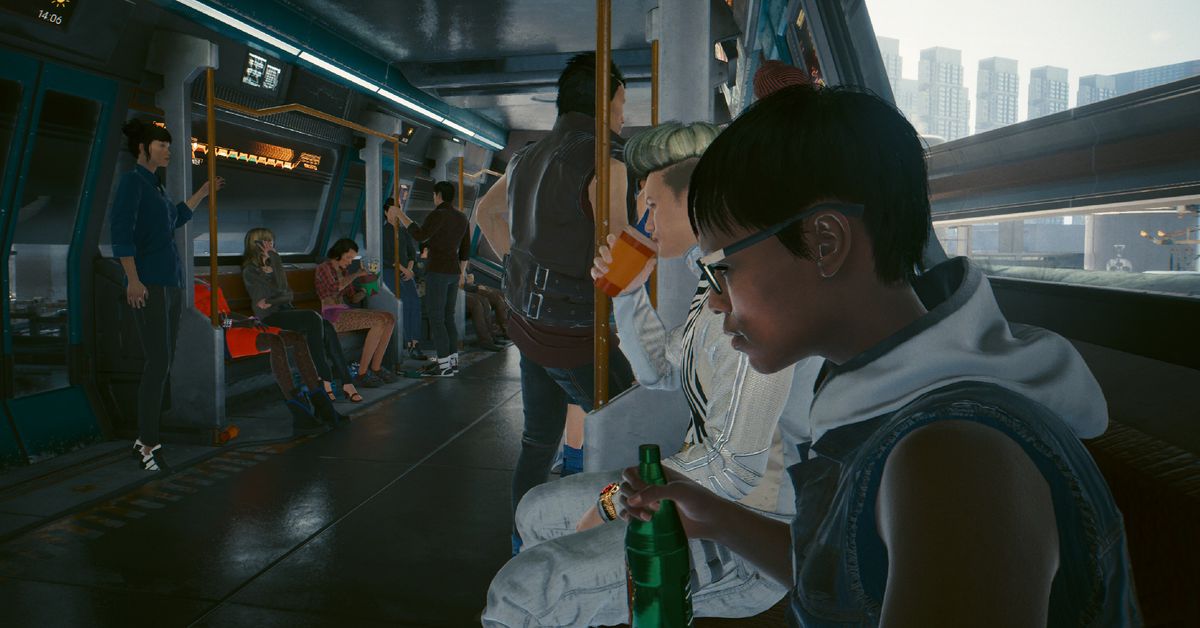CD Projekt Purple fulfilled a five-year promise final week when it added a totally useful metro system to Cyberpunk 2077. Whereas the characteristic does wonders to make Night time Metropolis really feel extra alive, I used to be shocked to study simply how little California’s public transportation infrastructure has improved within the recreation’s alternate-reality future.
Cyberpunk 2077 now contains 5 Night time Metropolis Space Speedy Transit (NCART) rail strains servicing 19 stations. Each cease nonetheless features as a quick journey level, however gamers may also use them to hop onto the subway and relocate, in actual time, to different elements of town. As motion is restricted whereas on the practice, it is a principally visible expertise, offering of us with a brand new perspective on the sprawling mega-city in addition to restricted alternatives to speak with their fellow riders.
Throughout one journey, I seen a display screen indicating the practice’s pace was persistently hovering round 43 mph, which felt awfully sluggish for futuristic transportation. The common speeds of modern-day heavy-rail methods in the US vary from the excessive teenagers to the mid-30s, however they’re able to reaching a lot larger maximums. And that’s not even accounting for extra developed public transportation in Japan and China, whose magnetic levitation (maglev) bullet trains zoom by way of main cities at lots of of miles per hour.
:no_upscale()/cdn.vox-cdn.com/uploads/chorus_asset/file/25158522/cyberpunk_2077_metro_screen_speed.jpg)
This suits with what the primary Cyberpunk rulebook needed to say about then-future transportation in 1988:
Shock, shock. Opposite to expectations, the 12 months 2000 has not yielded any staggering new developments in transportation. Years of financial strife and civil unrest have discouraged analysis into new methods to journey—in truth, the very act of journey has change into very restricted. Anticipate the world of 2013 to be very like the twentieth century—a community of crowded freeways, packed trains, and swarming airports.
A subsequent growth, Welcome to Night time Metropolis, signifies light-rail maglev trains with floor speeds of 200 mph existed within the eponymous metropolis way back to 2013, the 12 months the primary Cyberpunk adventures have been set. Each e-book since makes some point out maglev trains as a staple of Night time Metropolis journey, and 2005’s Cyberpunk V3.0 even famous an enchancment of their high pace to 300 mph regardless of the obvious destruction of the intercontinental maglev line throughout the Fourth Company Warfare (which happened from 2021 to 2025 in-universe) between the world’s ruling megacorps.
(And simply to cowl my ass, 1990’s up to date Cyberpunk 2020 rulebook makes it clear that NCART and the light-rail maglev trains are one and the identical.)
It’s right here that Cyberpunk 2077 does one thing intelligent by increasing the implications of this battle. Reasonably than solely placing rail journey between continents in flux, the sport describes the Fourth Company Warfare as debilitating your complete maglev system, as defined by the next database entry:
Maglev trains cruised at excessive speeds by way of tunnels and on the floor because of the appearance of electrodynamic suspension expertise, permitting quick and cozy journey from Night time Metropolis to different cities, together with Kansas Metropolis, St. Louis, Atlanta and Washington D.C. Sadly, this new period of transportation didn’t final lengthy. The social unrest and armed battle of the 4th Company Warfare introduced with it an financial disaster that quickly crippled your complete system. At the moment inoperational, the deserted Maglev tunnels are utilized by the homeless and numerous gangs.
The destruction of the maglev system and the sluggish NCART speeds exhibited in-game lead me to imagine the native authorities was compelled to revert to pre-2013 tech to make sure NCART remained operational, a large downgrade from the bullet trains that after transported residents by way of Night time Metropolis and past.
:no_upscale()/cdn.vox-cdn.com/uploads/chorus_asset/file/25158532/cyberpunk2077_metro_screen_crop_2.jpg)
Whereas researching this example, I couldn’t assist however see darkly hilarious parallels between the difficulties going through the fictional California depicted in Cyberpunk 2077 and the precise state wherein I stay.
Regardless of being one of many largest (each when it comes to land and inhabitants) and richest states within the union, California has lengthy struggled with plans to construct public transportation on par with the bullet trains of japanese Asia. A variety of that’s as a result of politics, as even ostensibly supportive legislators are cautious of spending the billions of {dollars} essential to finish the mission. And let’s face it: People are simply manner too dedicated to their automobiles.
All that mentioned, there’s one quite simple rationalization for Night time Metropolis metro’s comparatively low pace: The builders didn’t need NCART rides to occur within the blink of an eye fixed. What good would the long-awaited subway expertise be if gamers didn’t really, , expertise it?
A visit taken at 300 mph wouldn’t present any time to individuals watch Night time Metropolis’s eccentric residents or take within the view of skyscrapers surrounding the bay outdoors the practice’s home windows. The whole level of the subway system — and an enormous a part of why of us clamored for its inclusion all these years — is to provide gamers new alternatives to role-play and expertise the visible splendor of Cyberpunk 2077’s setting and its over-the-top aesthetics.
I discover it onerous to fault CD Projekt Purple for enjoying slightly free with established Cyberpunk historical past if it makes for a greater recreation ultimately.

